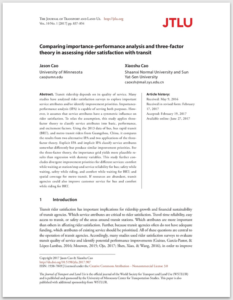Comparing importance-performance analysis and three-factor theory in assessing rider satisfaction with transit
Comparing importance-performance analysis and three-factor theory in assessing rider satisfaction with transit
- June 2017
- Peer-Reviewed Articles
- Multiple
 Cao, J., & Cao, X. (2017). “Comparing importance-performance analysis and three-factor theory in assessing rider satisfaction with transit.” Journal of Transport and Land Use, 10(1), 837-854.
Cao, J., & Cao, X. (2017). “Comparing importance-performance analysis and three-factor theory in assessing rider satisfaction with transit.” Journal of Transport and Land Use, 10(1), 837-854.
ABSTRACT: Transit ridership depends on its quality of service. Many studies have analyzed rider satisfaction surveys to explore important service attributes and/or identify improvement priorities. Importance-performance analysis (IPA) is capable of serving both purposes. However, it assumes that service attributes have a symmetric influence on rider satisfaction. To relax the assumption, this study applies three-factor theory to classify service attributes into basic, performance, and excitement factors. Using the 2013 data of bus, bus rapid transit (BRT), and metro transit riders from Guangzhou, China, it compares the results from two alternative IPA and two applications of the three-factor theory. Explicit IPA and implicit IPA classify service attributes somewhat differently but produce similar improvement priorities. For the three-factor theory, the importance grid yields more plausible results than regression with dummy variables. This study further concludes divergent improvement priorities for different services: comfort while waiting at station/stop and service reliability for bus; safety while waiting, safety while riding, and comfort while waiting for BRT; and spatial coverage for metro transit. If resources are abundant, transit agencies could also improve customer service for bus and comfort while riding for BRT.




